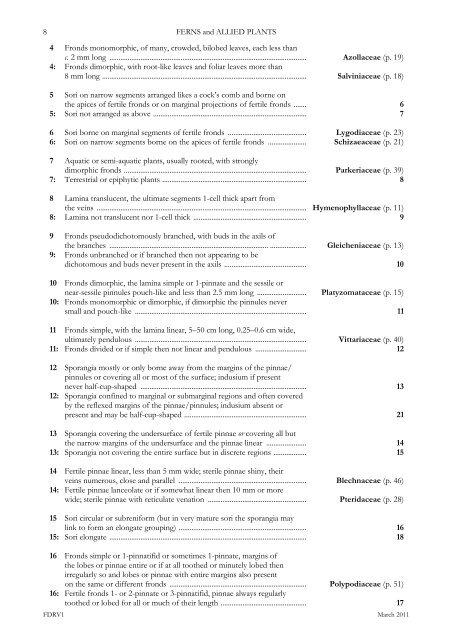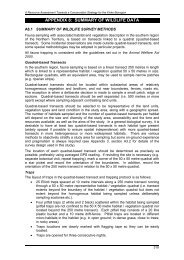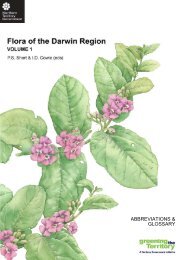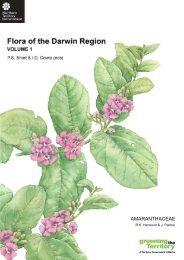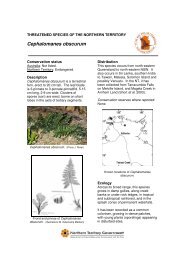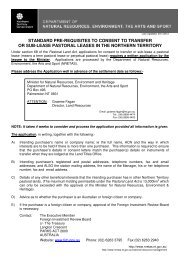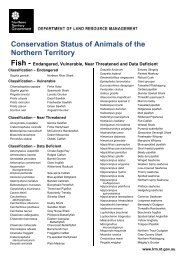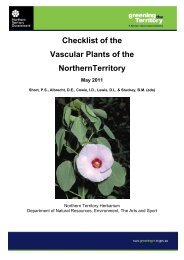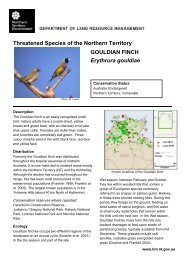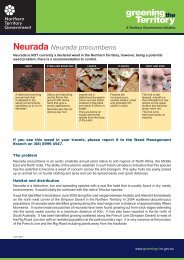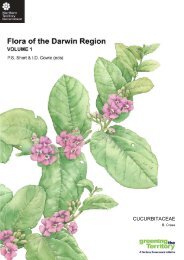ferns and allied plants - Department of Land Resource Management ...
ferns and allied plants - Department of Land Resource Management ...
ferns and allied plants - Department of Land Resource Management ...
Create successful ePaper yourself
Turn your PDF publications into a flip-book with our unique Google optimized e-Paper software.
8<br />
FERNS <strong>and</strong> ALLIED PLANTS<br />
4 Fronds monomorphic, <strong>of</strong> many, crowded, bilobed leaves, each less than<br />
c. 2 mm long ............................................................................................................ Azollaceae (p. 19)<br />
4: Fronds dimorphic, with root-like leaves <strong>and</strong> foliar leaves more than<br />
8 mm long ................................................................................................................ Salviniaceae (p. 18)<br />
5 Sori on narrow segments arranged likes a cock’s comb <strong>and</strong> borne on<br />
the apices <strong>of</strong> fertile fronds or on marginal projections <strong>of</strong> fertile fronds ....... 6<br />
5: Sori not arranged as above .................................................................................... 7<br />
6 Sori borne on marginal segments <strong>of</strong> fertile fronds ........................................... Lygodiaceae (p. 23)<br />
6: Sori on narrow segments borne on the apices <strong>of</strong> fertile fronds ..................... Schizaeaceae (p. 21)<br />
7 Aquatic or semi-aquatic <strong>plants</strong>, usually rooted, with strongly<br />
dimorphic fronds .................................................................................................... Parkeriaceae (p. 39)<br />
7: Terrestrial or epiphytic <strong>plants</strong> ............................................................................... 8<br />
8 Lamina translucent, the ultimate segments 1-cell thick apart from<br />
the veins ................................................................................................................... Hymenophyllaceae (p. 11)<br />
8: Lamina not translucent nor 1-cell thick .............................................................. 9<br />
9 Fronds pseudodichotomously branched, with buds in the axils <strong>of</strong><br />
the branches ....................................................................................... .................... Gleicheniaceae (p. 13)<br />
9: Fronds unbranched or if branched then not appearing to be<br />
dichotomous <strong>and</strong> buds never present in the axils ............................................. 10<br />
10 Fronds dimorphic, the lamina simple or 1-pinnate <strong>and</strong> the sessile or<br />
near-sessile pinnules pouch-like <strong>and</strong> less than 2.5 mm long ........................... Platyzomataceae (p. 15)<br />
10: Fronds monomorphic or dimorphic, if dimorphic the pinnules never<br />
small <strong>and</strong> pouch-like .............................................................................................. 11<br />
11 Fronds simple, with the lamina linear, 5–50 cm long, 0.25–0.6 cm wide,<br />
ultimately pendulous .............................................................................................. Vittariaceae (p. 40)<br />
11: Fronds divided or if simple then not linear <strong>and</strong> pendulous ............................ 12<br />
12 Sporangia mostly or only borne away from the margins <strong>of</strong> the pinnae/<br />
pinnules or covering all or most <strong>of</strong> the surface; indusium if present<br />
never half-cup-shaped ........................................................................................... 13<br />
12: Sporangia confined to marginal or submarginal regions <strong>and</strong> <strong>of</strong>ten covered<br />
by the reflexed margins <strong>of</strong> the pinnae/pinnules; indusium absent or<br />
present <strong>and</strong> may be half-cup-shaped ................................................................... 21<br />
13 Sporangia covering the undersurface <strong>of</strong> fertile pinnae or covering all but<br />
the narrow margins <strong>of</strong> the undersurface <strong>and</strong> the pinnae linear ...................... 14<br />
13: Sporangia not covering the entire surface but in discrete regions .................. 15<br />
14 Fertile pinnae linear, less than 5 mm wide; sterile pinnae shiny, their<br />
veins numerous, close <strong>and</strong> parallel ...................................................................... Blechnaceae (p. 46)<br />
14: Fertile pinnae lanceolate or if somewhat linear then 10 mm or more<br />
wide; sterile pinnae with reticulate venation ...................................................... Pteridaceae (p. 28)<br />
15 Sori circular or subreniform (but in very mature sori the sporangia may<br />
link to form an elongate grouping) ...................................................................... 16<br />
15: Sori elongate ............................................................................................................ 18<br />
16 Fronds simple or 1-pinnatifid or sometimes 1-pinnate, margins <strong>of</strong><br />
the lobes or pinnae entire or if at all toothed or minutely lobed then<br />
irregularly so <strong>and</strong> lobes or pinnae with entire margins also present<br />
on the same or different fronds ...........................................................................<br />
16: Fertile fronds 1- or 2-pinnate or 3-pinnatifid, pinnae always regularly<br />
Polypodiaceae (p. 51)<br />
toothed or lobed for all or much <strong>of</strong> their length ............................................... 17<br />
FDRV1 March 2011


